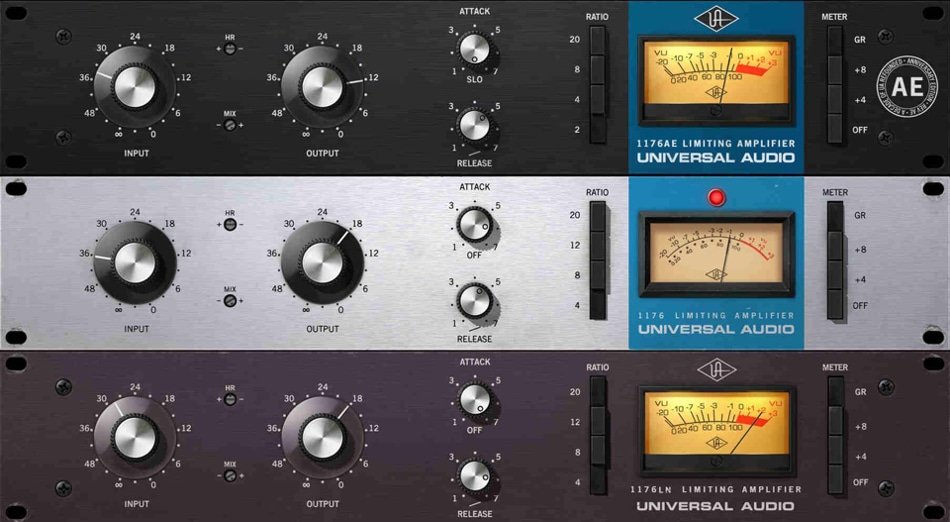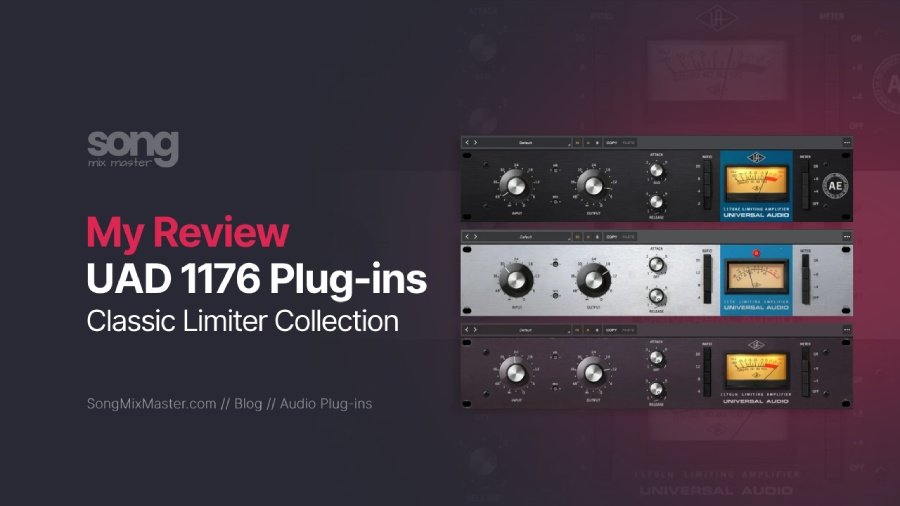Audio Plugins, Reviews
My Review: UAD 1176 Classic Limiter Collection VST Plugins
The UAD 1176 Classic Limiter Plug-In Collection brings this legendary analog piece to the digital world with incredible accuracy. It is a masterful recreation of one of the most iconic compressors in audio history. It offers three versions: Rev A (the “Bluestripe”), Rev E (the “Blackface”), and the rare 40th Anniversary Edition. Each version has its distinct character, but all share the same FET-based compression that made the original hardware legendary.
I spent countless hours using this plugin, and I can confidently say that it’s an indispensable tool in my mixing chain, whether I’m mixing drums, vocals, or any other elements that need punch and presence. In this review, I’ll walk you through the features, usability, and unique characteristics of each version in the collection.
Also read My Advanced Techniques & Tips for Mixing and Mastering
When I first used the Rev A, I noticed its rich, colorful distortion. It’s perfect for situations where you want your tracks to have a bit more grit and excitement, such as aggressive rock vocals or electric guitars. On the other hand, the Rev E has a cleaner, more controlled sound, making it ideal for more modern productions where clarity is key.
The 40th Anniversary Edition, with its rare 2:1 ratio setting, gives you an even more subtle form of compression, perfect for gluing a mix together without crushing dynamics.
Overview
The 1176 plugin from Universal Audio emulates the circuitry of the original 1176 hardware unit with incredible precision. Designed by Bill Putnam Sr. in the 1960s, this compressor/limiter was groundbreaking for using Field Effect Transistor (FET) technology. In the original 1176, FET was a voltage-controlled resistor in the compression circuit, allowing ultra-fast attack times and dynamic control over the audio signal.
Each version of the plugin collection: Rev A, Rev E, and the 40th Anniversary Edition, emulates slight variations in the original hardware circuits, such as the amount of distortion, compression response, and gain amplifier behavior. This meticulous attention to circuit modeling makes the UAD 1176 Classic Limiter Collection feel like working with the original hardware but with the added flexibility and precision of modern digital workflows.

- 1176 AE (Anniversary Edition): The most versatile of the three, this version introduces a unique 2:1 compression ratio, allowing for more gentle compression and a slow attack option (up to 10ms), which lets transients shine through more naturally.
- Rev A (“Bluestripe”): Known for its aggressive, gritty sound, this version is perfect for adding distortion and character to your tracks. It’s a bit more colored and adds a lot of harmonic excitement to the signal.
- Rev E (“Blackface” or LN for “Low Noise”): This is the cleanest version and the one I use the most. It handles almost any source, whether drums, vocals, or guitars. It gives you that classic 1176 compression without adding too much coloration.
Each version has its own specific characteristics, making this plugin bundle a highly versatile tool for any kind of mix.
User Interface

The UAD 1176 user interface is simple and intuitive, staying true to the original hardware unit’s design. At a glance, it’s easy to see the classic layout of input and output knobs, attack and release controls, and the familiar VU meter that displays either the gain reduction or output level.
One of the defining aspects of the 1176 interface is its simplicity of controls. There’s no dedicated threshold knob. Instead, the input control acts as a threshold by pushing the signal harder into compression. This design makes the 1176 unique, allowing you to shape the sound dynamically based on how much input signal is driven through it.
The 1176 operates differently from other compressors. The lower the attack/release setting, the slower the time. Overall, it’s a fast compressor, with attack times ranging from 20 microseconds to 800 microseconds and release times from 50 milliseconds to 1,100 milliseconds.
The attack and release knobs are highly responsive, with attack times ranging from lightning-fast to slower, smoother reactions. The ratio buttons on the right side of the interface let you choose compression strength (4:1, 8:1, 12:1, and 20:1), with an added “All-Buttons-In” mode that emulates the famous feature from the hardware unit.
The interface also features modern improvements over the original hardware, such as the Mix control for parallel compression and the Sidechain Filter, which provides greater control over low-end frequencies that can cause pumping during compression.
Sound
The 1176 is all about speed and character. The ultra-fast attack times, as low as 20 microseconds, make it perfect for taming transients while still preserving the punch of your recordings. Whether I’m dealing with vocals or drums, the 1176 has this ability to shape the sound in a way that feels aggressive yet musical.

On Drums: One of my favorite applications for the 1176 is on a drum bus, particularly using the Rev E for its smoother response. A common trick I use is the “All-Buttons-In” mode, where I engage all the ratio buttons simultaneously (4:1, 8:1, 12:1, and 20:1 while holding down the Shift key).
The “All Buttons In” mode, sometimes referred to as the “British mode,” is a classic feature of the original hardware 1176 compressor where all the ratio buttons are pressed simultaneously, creating a distinct and aggressive compression sound. This mode creates a unique, almost explosive compression effect that works wonders on room mics, adding size and energy to the drum kit. If you’re after that larger-than-life sound, this trick is a must-try.
For individual drum tracks like a snare, I often set a fast attack and release (around 1-2 ms attack and 50-100 ms release) to really tighten up the transient while allowing the tail of the drum hit to breathe. It gives the snare an aggressive snap that cuts through the mix without overwhelming it.

On Vocals: Vocals are another area where the 1176 shines. I typically use the Rev A version when I want to add a bit of harmonic distortion and color to a vocal. Setting the attack to medium and the release to fast allows the vocal to remain upfront without sounding overly compressed. The 4:1 ratio is my go-to setting for most vocal applications, giving just the right amount of control without choking the dynamics.
If the vocal requires more subtle treatment, I turn to the 1176AE with its 2:1 ratio. This is especially useful for more dynamic performances, where you want to smooth out the levels while retaining the performance’s natural feel.
Also read: The Role of Compressor Plugins in Audio Mixing & Mastering
Modern Features

The Mix control allows for parallel compression right inside the plugin, a feature I use constantly when working on bass or kick drums. This allows me to blend the compressed signal with the dry signal, maintaining the natural dynamics of the original sound while adding punch and weight.
The Sidechain Filter is another incredibly useful feature, especially for low-end heavy material. By filtering out the low frequencies from the compressor’s detection circuit, I can avoid the dreaded “pumping” effect on bass-heavy tracks like kick drums or bass guitars, which allows for more transparent compression.
Conclusion
The UAD 1176 Classic Limiter Collection is an absolute game-changer for anyone serious about music production or sound engineering. What I genuinely appreciate about Universal Audio is their meticulous attention to detail, something only experienced engineers recognize.
Including iconic features like the “all buttons in” trick, once an insider’s secret, shows how much they care about faithfully recreating the original hardware experience. The plugin captures the magic of the analog 1176 without the hassle of maintaining physical gear, and it’s incredibly close to the real thing in both sound and behavior.
This plugin delivers whether you’re compressing lead vocals, shaping drum transients, or adding character to room mics. It’s my go-to for lead vocals, especially at a 4:1 ratio for that perfect, in-your-face sound. The intuitive interface makes dialing the exact amount of compression you need in just a few moves easy. Plus, it handles extreme settings beautifully, making it ideal for creative compression techniques.
At its price point, the UAD 1176 Classic Limiter Collection is a steal, especially when paired with UAD’s Apollo Interface for real-time processing. Having A/B’d this plugin against actual hardware, I can confidently say Universal Audio nailed it. The UAD 1176 Classic Limiter Collection offers the best of both worlds: analog’s authentic sound and digital’s flexibility.
If you’re serious about getting your vocals or drums to sit right in the mix, this plugin is a must-have. Bill Putnam would surely be impressed by this digital incarnation of his legendary compressor.
Buy at Plugin Boutique: UAD 1176 Classic Limiter Collection
PS: While the UAD 1176 Classic Limiter Collection stands out for its attention to detail and authentic analog feel, there are other emulations that offer their own strengths depending on your needs, workflow, and budget. The Waves CLA-76, the Purple Audio MC77, or the IK Multimedia Black 76 are just a few of the 1176 emulations available that can improve your mix in different ways.


Disclaimer: Any references to any brands on this website/webpage, including reference to products, trademarks, brands and companies, are provided for description purposes only. We don't have any association with or endorsement by these brands or companies. Some of the links on our blog may be affiliate links. This means if you click on these links and make a purchase, we may earn a commission at no extra cost to you.
Check Out My New Fabfilter Pro-Q3 Presets Pack!
You may also like to read...
Hardware Vs. Plug-ins – Can Audio Plug-ins Replace Hardware?
How To Improve The Sound Acoustic in a Home Studio
7 Steps to the Perfect Mix in Hip-Hop, Techno, Rock, and Pop
Soundtoys Decapitator – The Secret to Authentic Analog Tone
How To “Calculate” The Compressor Release Time Correctly
My Advanced Techniques & Tips for Mixing and Mastering
Book My Mixing & Mastering Services